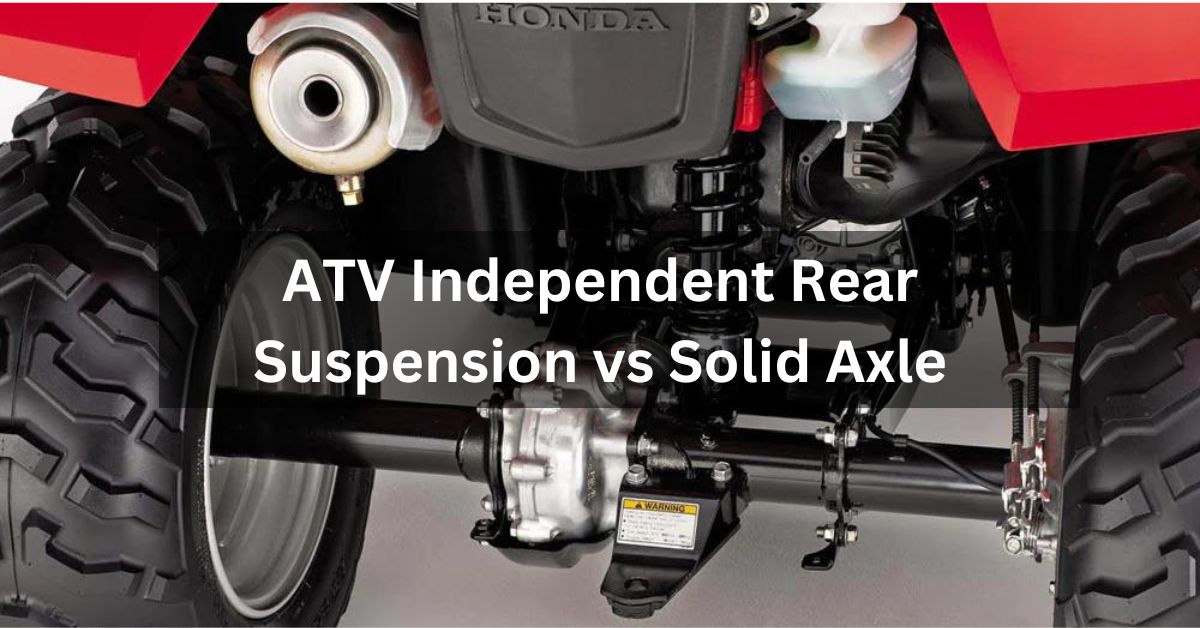When it comes to off-road vehicles like ATVs (All-Terrain Vehicles), one crucial factor that can greatly impact your riding experience is the type of rear suspension system it employs.
Two popular options that riders often consider are the Independent Rear Suspension and Solid Axle.
Independent Rear Suspension provides better individual wheel movement and improved ride comfort, while the Solid Axle offers a simpler design and durability. Both systems have their merits, and understanding the differences between them is essential for making the right choice.
In this comprehensive guide, we’ll explore the differences between ATV-independent rear suspension and solid axle systems. Make an informed choice for your off-road adventures.
Table of Contents
Exploring ATV Independent Rear Suspension – Check This Out!
An All-Terrain Vehicle (ATV) with Independent Rear Suspension refers to a type of suspension system that allows each rear wheel of the ATV to move independently from the other.
This is in contrast to a solid rear axle, where both rear wheels are connected and move together as a single unit. Independent Rear Suspension (IRS) offers several advantages for ATV performance and handling.
With IRS, each rear wheel can react independently to changes in terrain, bumps, and obstacles. This means that if one wheel encounters an obstacle or uneven terrain, it can move up or down without affecting the movement of the other wheel.

Pros:
- Improved ride comfort and control.
- Better traction on uneven terrains.
- Enhanced stability, especially during cornering.
- Reduced impact transfer to the rider.
- Adaptability to different riding styles.
However, it’s important to note that while the IRS offers numerous advantages, it can also have some drawbacks
Cons:
- A more complex system requiring occasional maintenance.
- Potential for higher costs in terms of repairs.
- Slightly reduced load-carrying capacity compared to solid axles.
Discover the Solid Axle Of ATV – Take A Look Here!
A solid axle is a type of suspension system used in vehicles, including All-Terrain Vehicles (ATVs). In a solid axle setup, both rear wheels are connected to a single, rigid axle. This means that when one wheel moves, the other wheel is also affected, as they are connected as a single unit.
Pros:
- High durability and resistance to tough conditions.
- Lower maintenance requirements due to simpler design.
- Better suited for heavy hauling and towing.
- Generally more cost-effective in terms of repairs.
Cons:
- Rougher rides on bumpy surfaces.
- Limited independent movement of wheels.
- Reduced stability during turns and corners.
- Lower overall traction in challenging terrains.
Some Key Differences Between Independent Rear Suspension And Solid Axle – Let’s Analysis!

1. Wheel Movement – Choose Your ATV’s Suspension wisely!
One fundamental distinction between Independent Rear Suspension (IRS) and Solid Axle lies in their wheel movement characteristics. IRS permits each rear wheel to move autonomously, allowing for greater adaptability to uneven surfaces and obstacles.
In contrast, a Solid Axle connects both rear wheels to a single axle, causing them to move in unison and restricting individual wheel adjustments.
2. Ride Comfort and Control – Elevate Your Off-Road Experience Today!
The divergence continues in terms of ride comfort and control. IRS, with its ability for independent wheel adjustments, offers an improved ride experience, heightened stability during turns, and superior control on diverse terrains.
Conversely, a Solid Axle may result in a rougher ride on uneven surfaces and reduced stability when navigating corners.
3. Terrain Traction:
When it comes to traversing various terrains, IRS and Solid Axle exhibit differing traction capabilities. IRS shines in this aspect by providing enhanced traction on uneven surfaces.
Each wheel’s capacity to react independently to changing conditions contributes to improved grip. On the other hand, Solid Axle configurations may encounter challenges in maintaining traction on demanding terrains due to limited wheel independence.
4. Durability and Maintenance:
Durability and maintenance considerations play a role in the choice between these suspension systems. IRS, due to its more intricate design, requires periodic maintenance, potentially leading to higher upkeep costs.
In contrast, Solid Axle setups feature a simpler construction that demands less maintenance, making them more resilient in rugged conditions.
5. Load-Carrying Capacity:
When it comes to carrying heavy loads or towing, IRS and Solid Axle again present varying capabilities.
IRS systems typically offer a slightly reduced load-carrying capacity compared to Solid Axle setups. Solid Axles are better suited for heavy-duty tasks, making them an optimal choice for scenarios such as farm work and hauling.
6. Cost Considerations:
The financial aspect further underscores the disparity between IRS and Solid Axle. IRS systems, with their complexity, can result in higher repair expenses and periodic maintenance costs.
On the other hand, Solid Axle configurations tend to be more cost-effective in terms of repairs and ongoing maintenance.
And there you have it! These are some key differences between IRS and Solid Axle. Take a look and implement the one that suits your needs. For more Community-based information, be sure to check the link above.
Selecting the Right Option: Which to Choose From Rear Suspension And Solid Axle?
The choice between ATV independent rear suspension and solid axle depends on your intended usage and preferences.
If you prioritize a smoother, more controlled ride on various terrains, and are willing to perform occasional maintenance, independent rear suspension might be the better option.
On the other hand, if you’re seeking a more robust and straightforward system that can handle heavy-duty tasks, the solid axle could be your ideal choice.
Frequently Asked Questions:
1. Which type of suspension is better for recreational trail riding?
For recreational trail riding, ATV independent rear suspension is generally a better choice, as it offers a smoother and more controlled experience on various terrains.
2. Can I retrofit my ATV with a different rear suspension system?
While it’s possible to make modifications, retrofitting a different suspension system can be complex and may require professional assistance.
3. Are there any specific maintenance tips for ATV independent rear suspension?
yes, maintaining proper shock absorbers, bushings, and pivot points is essential to ensure optimal performance of your ATV’s independent rear suspension.
4. Which system is more suitable for heavy-duty work on a farm?
Solid axles are better suited for heavy-duty tasks on farms, as they can handle heavier loads and tough conditions.
5. Does ATV independent rear suspension affect the ATV’s turning radius?
Yes, independent suspension systems can improve the ATV’s turning radius by allowing each wheel to move independently, enhancing maneuverability.
Conclusion:
In the realm of off-road vehicles, such as ATVs’ the choice between Independent Rear Suspension and Solid Axle depends on factors like ride comfort, terrain versatility, durability, and the intended usage of the ATV.
Both options find relevance, showcasing the importance of tailored decision-making for optimal off-road adventures.
